Pressure Canning Stewed Tomatoes
This post may contain affiliate links, which means that I may receive a commission if you make a purchase using these links. As an Amazon Associate I earn from qualifying purchases.
Capture the vibrant flavors of ripe tomatoes, celery, onions, and peppers in jars with this step-by-step guide to pressure canning stewed tomatoes. Your pantry will be stocked with jars of natural goodness, ready to elevate your dishes.
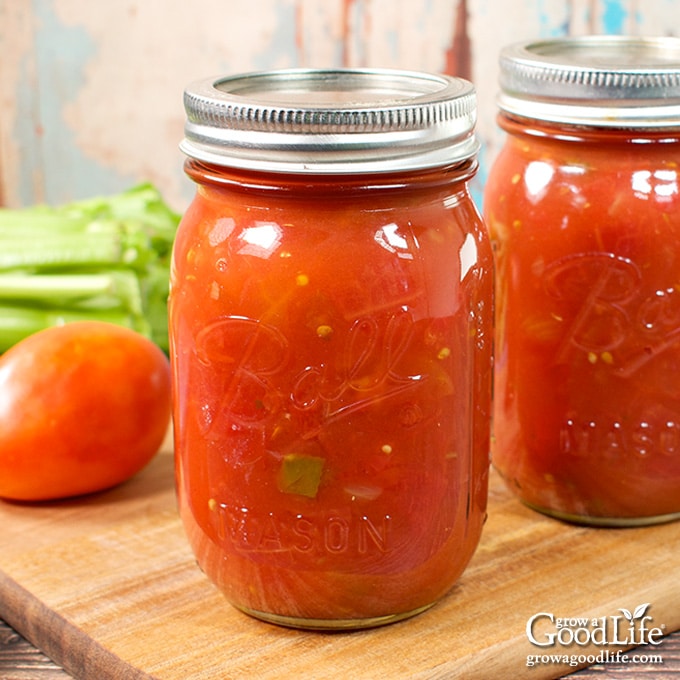
Stewed tomatoes are a versatile foundation for various recipes and can be enjoyed year-round, even during the off-season when fresh tomatoes may not be readily available. Once properly canned or preserved, they become a pantry staple, ready to add flavor to a wide range of dishes.
Whether used as a pasta sauce, an addition to soups and stews, a base for casseroles, or even a tangy topping for pizzas, stewed tomatoes bring summer flavors to your table.
What are Stewed Tomatoes?
Stewed tomatoes are made from ripe, juicy tomatoes cooked together with celery, onions, bell peppers, and seasoning.
Unlike plain tomatoes, stewed tomatoes offer a more complex taste profile, as the cooking process allows the flavors to meld together, enhancing the natural sweetness of the tomatoes while balancing it with savory and tangy notes from the other ingredients.

Ways to Use Stewed Tomatoes
Having a stash of home-canned stewed tomatoes in your pantry is like having a secret weapon that can transform your everyday recipes into delectable dishes bursting with rich flavors. Here are some common and creative ways to use stewed tomatoes:
- Pasta Sauces: Open a jar of stewed tomatoes, leave chunky, or blend them into a luscious pasta sauce. Season with herbs like basil, oregano, and thyme, and toss with spaghetti or pasta.
- Soups and Stews: Elevate your soups and stews by adding a jar of stewed tomatoes. They bring a comforting depth of flavor, whether you’re making classic tomato soup, vegetable soup, or a hearty beef stew.
- Casseroles: Give your casseroles a delightful twist by incorporating stewed tomatoes. They add flavor and moisture to dishes like lasagna, eggplant Parmesan, or green bean casseroles.
- Braised Meat: Use stewed tomatoes as a braising liquid for meats like chicken, pork, or beef. The tomatoes infuse the meat with delicious flavor, resulting in tender and juicy dishes.
- Slow Cooker Recipes: Adding a jar of stewed tomatoes along with boneless chicken, pork chops, or pot roast is an easy and delicious way to infuse flavor into your favorite crockpot recipes.
With a jar of stewed tomatoes on hand, your culinary possibilities are virtually limitless. Let your creativity run wild, and relish the convenience of having these flavorful jars at your disposal whenever you’re ready to whip up a scrumptious meal!
About the Ingredients
This is a classic recipe for stewed tomatoes made from tomatoes, celery, onions, green peppers, sugar, and salt. As with any preserved product, select ingredients that are at the peak of ripeness and free from any signs of insect damage, rot, or disease.
- Tomatoes: While any variety of fresh tomatoes can be used, I recommend mixing your favorite beefsteak and heirloom tomatoes with plum tomatoes, such as Roma, for a balance of flavor and texture. You’ll need about 8 pounds of tomatoes to yield 16 cups or 4 quarts of peeled, cored, and chopped tomatoes.
- Celery: Adding additional texture and flavor to the mix. Feel free to use either fresh or frozen celery. You’ll need about 2 stalks of celery to get 1 cup of chopped celery.
- Onions: You can use any bulb onion variety, such as yellow, white, or red, based on your preference and availability. About 1 small onion will give you 1/2 cup of chopped onions.
- Peppers: While this recipe specifically calls for green bell peppers, you can safely experiment with different fresh pepper varieties to introduce varying flavors. However, do not exceed 1/4 cup of chopped peppers as stated in the recipe to ensure safe canning.
- Seasonings: Sugar sweetens the tomatoes, balancing their natural acidity, while salt adds flavor, enriching the taste. Depending on how you use your stewed tomatoes, you can also add up to 1 teaspoon per jar of dried herbs and seasonings for additional flavor if you’d like. Or you can omit the seasonings before canning and season the stewed tomatoes according to your recipes after opening the jar to prepare meals. I usually skip the salt when I can stewed tomatoes.
Step-by-Step Guide to Home Canned Stewed Tomatoes
Since this recipe involves a tomato-vegetable mix without added acid, a pressure canner is required for safe canning. It’s the only way to get the high temperatures needed to kill any harmful stuff that might cause food borne illnesses. But no worries, if you don’t have a pressure canner, you can use this Minnesota Mix Stewed Tomatoes water bath canning recipe instead.
Having a good pressure canner is a smart investment for home food preservation. Brands like Presto, Mirro, and All-American are some trusted ones. Before diving in, make sure to check out the “Using Pressure Canners” guide on the National Center for Home Food Preservation website. Also, get familiar with the instructions for your pressure canner, and make sure it’s all clean and working fine.
This stewed tomatoes recipe is the classic “Stewed Tomatoes” from the Ball Blue Book Guide to Preserving. You can find the complete, printable recipe card at the bottom of this article, but these are the detailed steps for making and canning stewed tomatoes. So, if you’re ready to can some tasty tomatoes and veggies, let’s get cooking!
Step 1: Gather Your Kitchen Equipment
Before you begin, make sure you have all the essential kitchen tools and equipment ready to go. Here’s what you’ll need:
- Pressure Canner with Canning Rack: Since we’re canning a tomato-vegetable mix without added acid, a pressure canner is essential to reach the high temperatures necessary for safe canning.
- Canning Jars: You’ll need 6 pint-sized canning jars, or if you prefer larger portions, 3 quart-sized jars.
- Canning Lids and Bands: Make sure you have new lids for each jar, while the bands can be reused.
- Canning Tools: A jar lifter for safe handling, a canning ladle to fill the jars, a funnel for mess-free pouring, and a bubble popper to remove any air bubbles.
- Basic Kitchen Supplies: A large stainless steel saucepan, knife and cutting board, large prep bowls, measuring cups, slotted spoon, and plenty of clean kitchen towels.
Step 2: Prepare the Canning Equipment
Thoroughly wash the canning jars, lids, bands, and canning tools in hot, soapy water. Give them a good rinse to remove any lingering suds. Set the lids and bands aside to air dry until they’re ready to be put to work.
Place the jar rack into the pressure canner. Add water per your pressure canner manufacturer’s instructions: For Presto, you’ll need 3 quarts of water, while Mirro calls for 2 quarts, and All American suggests filling it 2 to 3 inches deep.
Fill the jars halfway with water and place them upright in the canner. Turn on the burner, bringing the canner to a simmer for 10 minutes. Keep the jars hot (180°F) until you are ready to fill them.
Step 3: Prepare the Vegetables
This recipe calls for chopped tomatoes, celery, onions, and peppers. This means you will peel, seed, and chop your vegetables before measuring using measuring cups.
Wash the vegetables under clean, running water, and place them on a towel to air dry. Then prepare the vegetables one at a time so you can measure each accurately. Chop into pieces and add to a measuring cup as you go until you reach the required amounts.
Prep the Tomatoes
To peel tomatoes, bring a large pot of water to a rolling boil over high heat. While it is heating, fill a large bowl with ice and cold water. Need more details? Check out our detailed tutorial: How to Skin Tomatoes.
Blanch the tomatoes in the boiling water for around 60 seconds or until the skins crack. Then, use your slotted spoon to remove them from the boiling water and dunk them into the bowl of ice water to stop the cooking. Repeat until all the tomatoes are blanched.
While they are cooling, empty the water out of the large saucepot, wash with soapy water, rinse well, and dry. You will use this pot to heat your stewed tomato mixture before filling the jars.
Once the tomatoes are cool enough to handle, remove the peelings and cores and chop them into large pieces. Measure the chopped tomatoes and add 16 cups to the large saucepot.
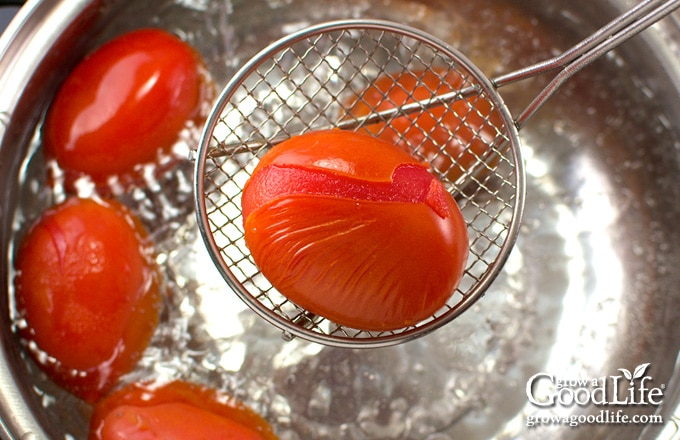
Prep the Vegetables
- Celery: Start by removing the leafy tips, trimming the bottom white sections of each stalk, and cutting the ribs into 1/2-inch pieces. Measure 1 cup of chopped celery, and toss it into the pot with the tomatoes.
- Onions: Peel and chop the onion. Measure 1/2 cup of chopped onion and add it to the pot.
- Peppers: Remove the stem, seeds, and membranes. Then cut into 1/2-inch pieces. Measure and add 1/4 cup of chopped peppers to the pot.
Step 4: Simmer the Tomatoes and Vegetables
Place the pot of prepared tomatoes and vegetables on the stove. Add the sugar and salt, and stir to combine. Cover and bring the pot to a gentle boil over medium-high heat. Then reduce the heat to a simmer. Cook until the juices are released, and the vegetables begin to soften, about 10 minutes. Stir occasionally to prevent sticking. Keep the mixture hot as you fill your jars.
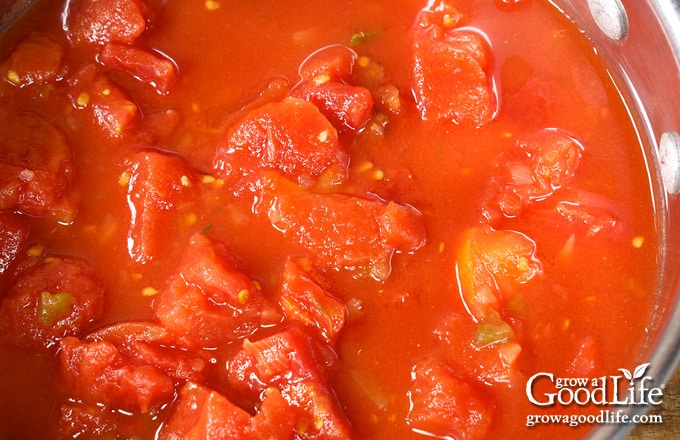
Step 5: Can the Stewed Tomatoes
Spread a dry kitchen towel on the counter. Grab the jar lifter and remove a jar from the canner. Pour the water out (you can save it for washing dishes), and place the jar on the towel. Keep the other jars in the canner so they stay hot.
Place the canning funnel on the jar. Use the slotted spoon to pack the jar with the hot tomato and vegetable mixture, leaving about 2 inches at the top of the jar. Then use the ladle to top the jar with liquid while leaving a 1-inch headspace. Run the bubble popper through to release any trapped air bubbles, and adjust the headspace again if needed.
Wipe the rim of the jar with a damp towel to remove any residue. Center a lid on the jar, place the band over the lid, and screw it on until fingertip tight. Return the jar to the canner, and repeat with the rest of the jars until they’re all filled up and ready to go.
Follow the directions for your pressure canner to seal, vent, heat, and process the jars for the times indicated in the recipe below.
Once the processing time is done, turn off the heat, and let the pressure return to zero naturally. Remove the jars, let them cool completely for 12 to 24 hours, and test the seals. Then, wash the jars, date, label, and store the canned stewed tomatoes in a cool location. Use within 12 to 18 months for the best flavor.
And there you have it – your very own homemade stash of stewed tomatoes, ready to add some serious yum to all your favorite recipes!
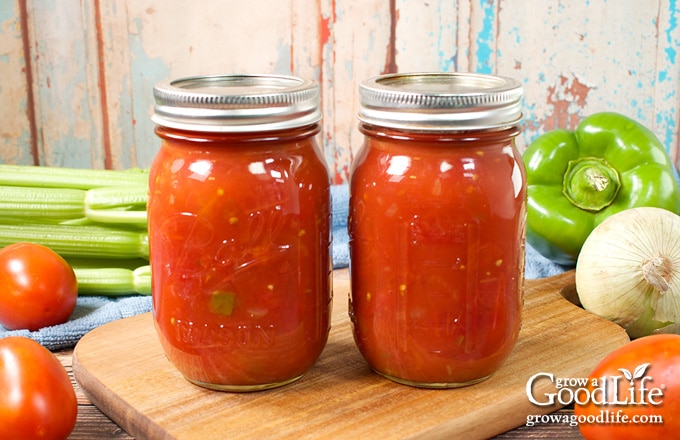
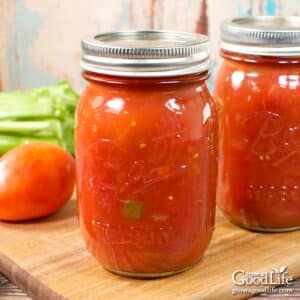
Pressure Canning Stewed Tomatoes
Ingredients
- 16 cups peeled, cored, chopped tomatoes (about 8 pounds before prep)
- 1 cup chopped celery (about 2 stalks before prep)
- 1/2 cup chopped onions
- 1/4 cup chopped seeded green bell pepper
- 1 tablespoon granulated sugar optional for flavor
- 2 teaspoons salt optional for flavor
Instructions
Prepare the Canning Equipment:
- Wash the jars, canning lids, and rings in hot soapy water and rinse thoroughly. Set the lids and bands aside until you are ready to use them.
- Place the jar rack into the pressure canner, and fill with water per your pressure canner manufacturer’s instructions: Presto is 3 quarts, Mirro is 2 quarts, and All American is 2 to 3 inches.
- Fill the jars halfway with hot water, and then place them on the rack in the canner.
- Bring the canner to a simmer for 10 minutes (180˚F). Keep them hot until you are ready to fill them.
Simmer the Tomatoes and Vegetables:
- Add the prepared tomatoes, celery, onions, peppers, sugar, and salt to a large stainless steel saucepot, and stir to combine.
- Bring the mixture to a boil over medium-high heat, then reduce the heat, and simmer (180˚F) for 10 minutes. Stir occasionally to prevent sticking.
Fill the Jars:
- Lay a towel on the counter. Use your jar lifter to remove a jar from the canner. Pour out the water (save it for washing dishes), and place the jar on the towel. Keep the remaining jars in the canner so they stay hot.
- Use your canning funnel and ladle to fill the jar with the hot mixture, leaving 1-inch headspace.
- Remove air bubbles with the bubble popper, wipe the rim to remove any residue, center a lid on the jar, and screw on a band until it is fingertip tight.
- Use the jar lifter to place the jar back into the canner and repeat with the remaining jars.
Can the Stewed Tomatoes:
- Place the lid on the canner and lock it. Leave the vent open, adjust the heat to medium-high, and bring the canner to a boil. Allow the pressure canner to vent steam for 10 minutes, place the pressure regulator on top of the air vent, and let the pressure rise.
- Once the canner has reached the correct pressure (10 pounds for weighted gauge and 11 pounds for dial gauge pressure canner), set a timer and process pint jars for 15 minutes, and quarts for 20 minutes at altitudes of less than 1,000 ft.
- Adjust altitude if necessary (see chart below), and regulate the heat as needed to maintain a steady pressure.
- When the processing time is complete, turn off the heat, and let the pressure canner cool down to 0 pressure. Once the canner is depressurized, let the canner cool additional 10 minutes before removing the lid.
- Spread a dry towel on the counter, unlock the cover, and remove it by tilting the lid away from you so that steam does not burn your face.
- Allow another 10 minutes for the jars to adjust to the change in pressure. Then, if the jars are still boiling vigorously, let them sit in the canner for another 5 minutes or until the boiling slows.
- Use the jar lifter to lift jars carefully from the canner and place them on the towel. Keep the jars upright, and don’t tighten bands or check the seals yet. Let the jars sit undisturbed for 12 to 24 hours to cool.
- After 12 to 24 hours, check to be sure the jar lids have sealed by pushing on the center. The cover should not pop up. The jar failed to seal if the top flexes up and down. Refrigerate it and use it within a few days.
- Remove the screw-on bands and wash the jars in warm soapy water. Label, date, and store the jars in a cool, dark place for 12 to 18 months. Once the jar is open, refrigerate and use up within a week. Yields about 6 pints or 3 quart jars.
Notes
Nutrition

Explore More Stewed Tomato Recipes!
Discover a delightful assortment of stewed tomato recipes to tantalize your taste buds further! These recipes are perfect for elevating your home-canned creations:
- Mexican Style Stewed Tomatoes and Chiles: Create your own Rotel-style tomatoes with this pressure canner recipe. Perfect for adding a zesty twist to your favorite Mexican dishes and a must-have pantry staple for spice enthusiasts.
- Canning Plain Stewed Tomatoes: This crushed tomatoes canning recipe keeps it simple yet delicious. Safely preserved using a water bath canner, these plain stewed tomatoes will bring a burst of natural goodness to any recipe.
- Minnesota Mix Tomatoes and Vegetables: Discover the delightful combination of vegetables and stewed tomatoes with this water bath canner recipe. Developed and tested by the Minnesota Extension, it’s a safe and wholesome addition to your pantry.
40+ Meals in a Jar Pressure Canning Recipes
In this eBook, you will find 50 pressure canning recipes, including 44 meals, along with homemade stocks and bone broths. Recipes include soups, stews, chilis, beans, beef, pork, and poultry. Explore the world of preserving delicious home-cooked meals for all seasons.

